Is traveling dangerous? Well, I guess it depends on the traveler. If you’re leaning toward extreme adventure travel, your risk management probably differs from someone who wraps themself in bubble wrap before stepping out the door. The world is definitely becoming less safe than it was, but some travel risks never change. It’s Pipeaway’s seventh birthday, people! To mark that lucky number, I decided to share seven heart-pounding situations where I willingly and sometimes stupidly played with good luck. I’ll share the dangers of travel I encountered over the years, particularly those where I risked injuries, health, well-being, and even loss of life.
This selection of dangers of traveling reveals situations where I thoughtlessly stepped into preventable troubles
I already debunked some illusions of travel coming from the perception of a blogger’s life. You don’t get to read about travelers’ stomach problems and diarrhea disasters often, simply because that’s not sexy. Journey reports in blogs and social media may paint experiences in rosy hues, just because it’s embarrassing to admit one’s travel mishaps.
We can also feel ashamed to share that we became victims of scams, assaults, thefts, and other crimes. In this collection of anecdotes, I won’t be writing about that time when my friend Timon and I walked into an Istanbul brothel thinking we were just invited for a beer, but were then pressured to choose between all Tatianas paraded in front of us as if they were a treat on a sushi conveyor belt. I’ll skip a series of pickpocket attempts in Addis Ababa or even that transfer-kidnap story in Manila I hinted about in the selection of the greatest WTF moments of my travels.
Today’s selection of dangers of traveling is all about risking injuries, situations where I thoughtlessly stepped into preventable troubles. Hopefully, you’ll find safety tips that should help you avoid similar mistakes on your travels!
WARNING: This article contains graphic images of exposed wounds that some viewers might find disturbing.
7 Dangers of Travel
1. Burning my soles in the Vietnamese desert
On my first extended Asian adventure, seven years ago, I stopped in Mui Ne, a resort town on the southern part of Vietnam‘s coast. This unusual place had over a hundred resorts claiming parts of the beach, securing direct sea approach and unobstructed views to their guests. But there was plenty of sand north of the town, in Mui Ne’s famous Red Sand Dunes.
To avoid the crowds who visit the enormous desert attraction with jeep tours, I decided to avoid their favorite “golden hours” of early morning and late afternoon. With a local bus, I arrived just before noon, thinking how I outsmarted everyone.
It was hot, as one would expect from a midday, but nothing unbearable. I coated myself in sunscreen and walked barefoot over the dunes. The warmth of the sand was pleasant, but another of my senses was more occupied – the views were fantastic.
The temperature of the sand is not equal across the dunes, you know. As the sun moves, so do the dune shadows. But it never occurred to me that some sections were constantly exposed to the sun. Well, not until my bare feet stepped into an area that felt like a roof of hell. I literally screamed in agony.
It took me some time to untangle the Gordian Knot I used to safely attach my flip-flops to the backpack. At the same time, I was trying to do a little Irish dance, jumping from one foot to another. It wasn’t helping; I was being grilled alive.
With sand in my mouth, hair, and everywhere else you can imagine it sneaking in, I returned to the civilization. The tingling sensation in my blistered feet continued reminding me that the dangers of travel lurk when you least expect them.
2. Dehydration drama in Cambodian outback
While traveling through Cambodia, I stopped in Kampong Chhnang, a sleepy port town with a floating village on the Tonle Sap River.
Just after Songkran, the Cambodian New Year, many businesses took additional days off, and life slowed down. Finding even a working restaurant or a shop that would sell me a hand of bananas was challenging.
Arming yourself with water is essential, especially if you intend to ride a bicycle out in the sticks, through a tropical countryside. It was so dry that you could easily count ribs on cows searching for a green blade of grass.
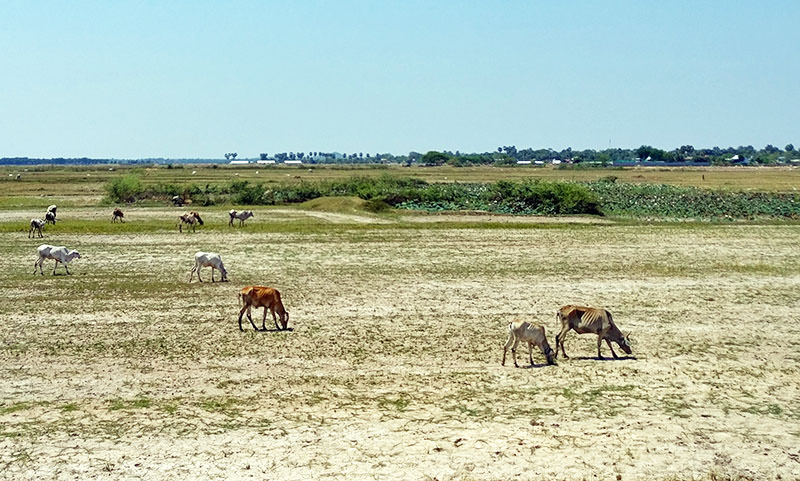
I love exploring the countryside on a bicycle, but that takes energy away. One can easily miscalculate the appropriate intake of fluids, so I try to be conservative when dispersing the content of a water bottle I have.
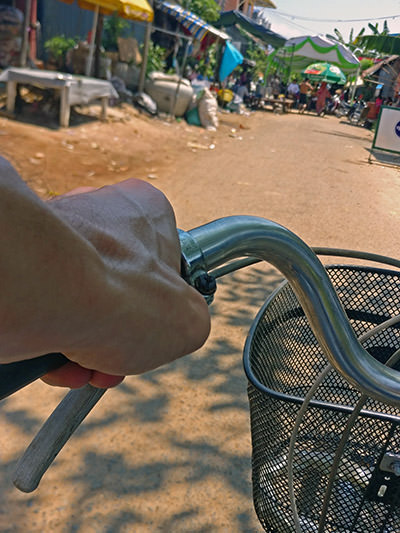
I decided to pedal toward a restaurant completely out of route, hoping it would provide sustenance, but met another closed door. To eat something, I went further away from town, and practically drained what little energy I had left.
My mouth felt so dry that even sipping the remaining water felt insufficient to quench the thirst. One of the scariest dangers of travel in tropical zones crept in. I pondered about waiting for the sunset under a tree before moving on. It was extremely hot, and finding any shop on the way home didn’t look promising.
But standing on the side of the road didn’t sound like the best choice either. Eventually, I concluded I would faint in any case. I summoned the last shreds of my strength and rode toward a pottery shop, in whose shade I took a little break, before eventually successfully getting home, hungry, thirsty, and utterly exhausted.
3. Falling down the stairs in Bulgaria
It was raining cats and dogs when I arrived in Plovdiv, the oldest city in Europe. The clouds opened up, and a massive quantity of water poured down the streets of the Bulgarian cultural capital.
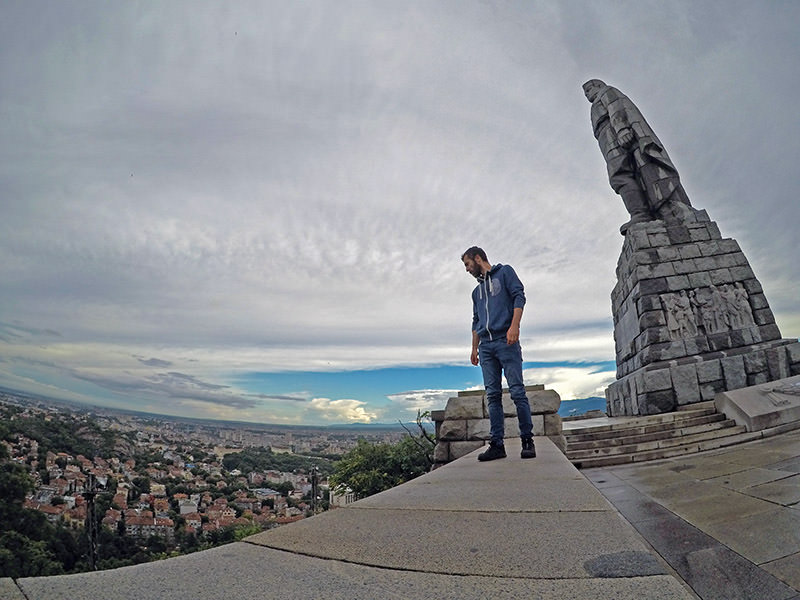
I was staying in a hostel, and Max, a young German ornithologist returning from a bird mapping expedition in Azerbaijan, joined me at the supermarket to get some food.
After returning home, we descended to the kitchen, and my shoes just glided off the slippery wooden stairs. I flew through the air and crash-landed with the finesse of a sack of potatoes. I hit my back, buttocks, and mostly the left arm, peeling off the skin as I met the floor.
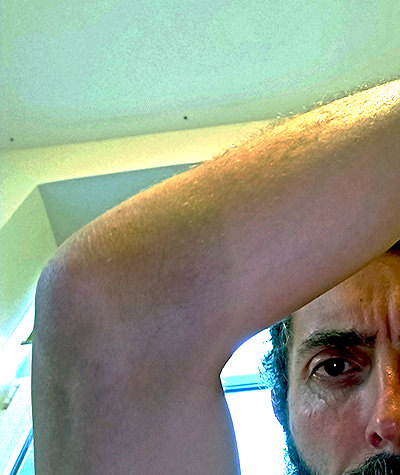
A swelling in the left elbow was hurting for days. There was another female guest in the hostel, whose name I forgot, probably because anger overtook me. She approached me, and squeezed my bruised elbow as hard as she could, to make sure “if it hurt”. I erased your identity from my memory, lady, but you are a very bizarre person! These were not health and safety protocols I would expect from a roommate.
Somehow, I healed on my own, reluctant to seek medical attention. I guess the danger of travel that doesn’t kill us, makes us stronger. But there are better things than getting stronger in an unconventional way! For instance, I would’ve preferred to hold the handrail while descending instead of making this unplanned acrobatic venture that wouldn’t bring me any points in figure skating competitions.
Anything can happen on a trip in a foreign country, from fractures to food poisoning. Prevent worries and protect yourself against costly bills by taking EKTA insurance with a worldwide coverage. Buy your policy now!
4. Fracturing my ribs in a bathtub in Finland
In Helsinki, the capital of Finland, I experienced one of the most painful travel moments. At the hotel I stayed in, I took an evening shower. After finishing, I reached out for a towel hanging on the bathroom door. In the next second, I slipped and fell, my back loudly kissing the ceramic surface.
The impact knocked the air out of my lungs. It took me a second to be able to produce a painful moan. I wasn’t sure if I could move. The first thought that rushed through my head was: “Shoot, I locked the door, and even put the ‘Do Not Disturb’ sign out! It will take days for them to find me.”
Immediately, I was aware of how helpless I was. My mobile phone was in the bedroom. There was no emergency string to pull. So I just lied there.
In Japan, seven-times more people die in bathtubs than in car accidents
As I recovered from the initial shock, I managed to drag my sorry self out of the bathtub somehow, and slowly got to bed, making sure that the phone would be within my reach. The pain was excruciating, and yet, I wanted to believe that I would be fine by morning.
I wasn’t fine. The doctor arrived at the hotel and quickly diagnosed mini-fractures of my ribs. Even his bill was painful; 200 euros for advising me to rest.
In the following days, I managed to get out, but navigating the city was hard. I couldn’t cross two-lane streets during a green light. I limped my way through Helsinki, extremely slowly. The recovery would be long.
To this day, I wonder: what diabolical cleaning products do they use in hotel bathrooms? Those bathtubs must be coated in a layer of slippery devilry, contributing to the scary slip-and-fall statistics.
In Japan, 19,000 people die in a bathtub every year. That’s seven-times more fatalities than in car accidents. In the United States, it is three-times likelier one would die in a bathtub than in a terrorist attack.
5. Falling off a motorbike in Laos
Luang Prabang is protected by UNESCO, but on the road, you are on your own. If you don’t take all travel safety precautions when navigating Laos, nobody will do it for you.
In the afterglow of a day spent chasing the enchanting Kuang Si Falls, I was returning to the town on a rented scooter. On my way to the waterfall, I already learned I should steer clear of potholes. But potholes would not be my problem.
On this scorching hot day, a tree was shading the road, right at the spot that would make me lose balance. Hidden by the shadow, there was a sneaky little bump. I saw it too late.
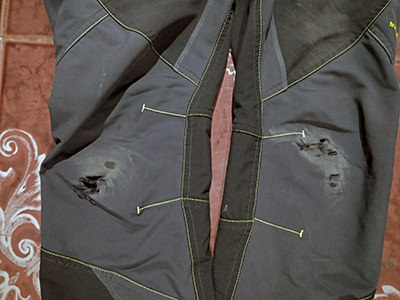
Me and my motorbike fell, gliding across the asphalt road as if it were butter. It wasn’t butter. My bleeding hands, scratched arms (that poor left elbow taking another hit), and ripped trousers that would only later expose wounds on my knees too.
Kind-hearted girls behind me stopped when they saw me lying down, removed the scooter from the road, and rushed to the nearby village to get a disinfectant for my wounds.
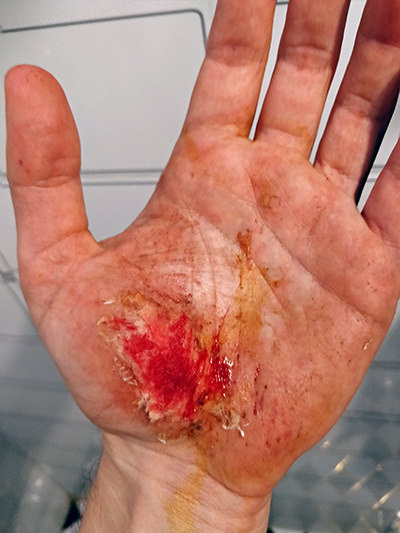
I was lucky that nobody and nothing else participated in my accident. It was only a collision with a hard floor. Otherwise, it might have ended up differently for me. As I was driving back to the town, the faces of people who mean the most to me, rushed before my eyes.
They say that medical care in Laos is not of a high standard, so even if you need to go to a hospital, many advise you to head to the neighboring Thailand instead. I nursed my wounds myself, with supplies from the pharmacy. But I knew that my days of exploring dusty Laos roads with open wounds had to come to an earlier end.
6. Descending the Gheralta Moutain without a rope
There’s a lot I could tell you about the dangers of travel through Ethiopia, a country I visited during the state of emergency. I have already written about my conflict with fraudsters in an Ethiopian bus, my encounter with hyenas in Harar, a swim in Doho Lake with crocodiles, a police-alarming incident with Chinese tourists at Bete Giyorgis, as well as climbing Erta Ale volcano with armed escort. It’s a country that offers travelers many opportunities for danger, from pickpocketing scams to natural challenges.
It may not look like I have any issues with heights (remember those daring hikes in Norway?). But every encounter with a cliff is not just exciting for me, it’s also quite terrifying. Even with my circus background, I’m still aware I am conquering fears, and not being fearless. I’m not one of those daredevils who run on skyscraper edges; those videos make my stomach churn.
But I do love culture, especially one that has a rich history. So I couldn’t skip Tigray Churches, nestled high in the Gheralta Mountains. Religious sanctuaries carved in the rock, at some truly special sites, were calling my name.
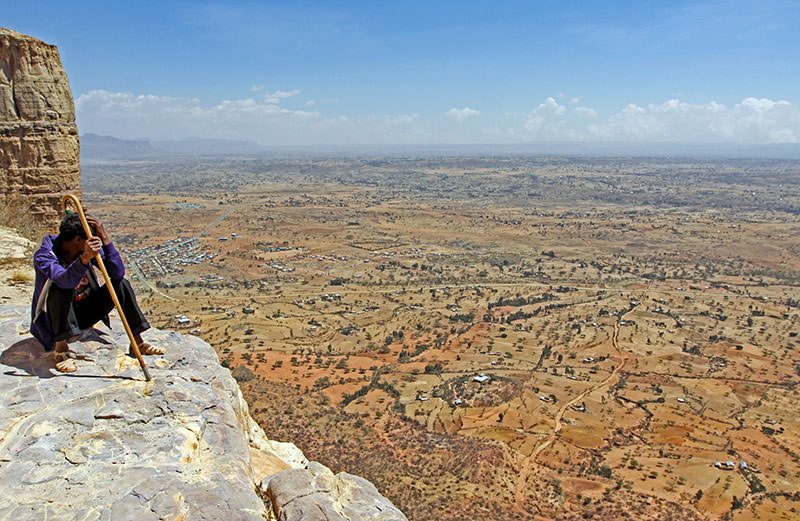
The routes through these hardly accessible mountains are not signposted, so you cannot visit them without a guide. In the town of Megab, I booked Amaze, my trusty expert for the day. I took the package that included him, a motorbike to take us to and back from the mountain, and – a rope, supposedly for easier climbing.
The plan was to visit the churches of Daniel Korkor and Mariam Korkor, and then a somewhat dislocated Abuna Yemata Guh.
The initial ascend between the rocks that were “separated by God” (similar to what Moses did with the Red Sea) was quite strenuous. However, the real challenge happened when Amaze took me for a shortcut way to Abuna Yemata Guh, but forgot that rope I rented out. Instead of taking it with us, he mistakenly sent it directly to our final church.
Now, this descent without a rope was quite… How to describe it? In several instances, I had to say “Are you sure? Maybe we should head back?” Even for a person of reasonable fitness, there were some scarily steep parts. I still wonder how the two of us survived this heart-stopping trek.
The exhausting hike through pure wilderness between the two sites took its toll. When we arrived beneath the third church (and finally used the rope to ascend the rocks), I was already deadbeat from the sun. On the top rock, a vertigo got me. The views of a 2.5-kilometer drop beneath us and a petrifying walk on the cliffside didn’t help. It all felt messed up now, as I tried to make my weary body not lose balance on a narrow ledge.
I survived, like many before us, but I wouldn’t recommend the warm-up we had to anyone planning this hazardous visit.
7. Breathless experience of scuba diving in Greece
For us humans (we are not fish, right?), the ability to breathe is what keeps us alive. Even if I can apply for a trip to the Moon, or readily visit the most toxic place on Earth – Kawah Ijen volcano in Indonesia – I don’t take breathing in environments that are not built for our lungs for granted.
My possibly closest brush with death happened during my first scuba diving attempt in Naxos, Greece. Maybe it’s not fair to call it a near-death experience. The reason why I’m able to tell this story today is that I actually had skilled professionals taking care of me along the way. However, this doesn’t annul the panic attack I experienced that day below the surface.
Everything went fine on my initial scuba diving training. I felt confident with instructions on dry land, the shallow-water drill went great, and then there were also three people taking care of me, my Greek instructor, and two diving volunteers from Bulgaria. Sure, let’s go deeper!
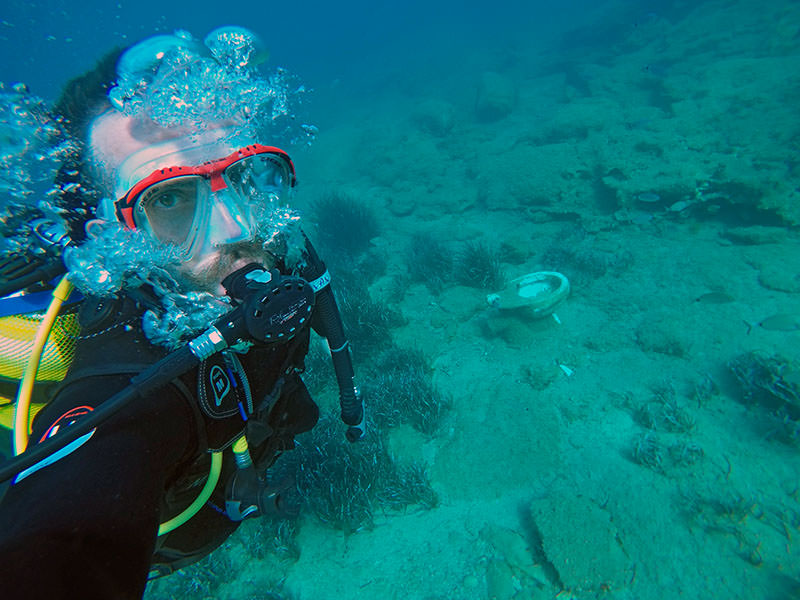
Maybe I was exuding too much confidence. I was able to both dive and film the experience; my instructors later told me they were impressed. Another student canceled just before the dive, while I seemed fearless.
But at one moment, the first moment my instructor Panos looked away (I guess I was radiating confidence), something happened. I wasn’t able to inhale through my scuba gear. Panic mode: activated. I tried pinching and blowing my nose, but it didn’t help. Maybe because that’s a method for equalizing ear pressure.
Indeed, I was taught about the inflator hose, and that the inflate button would allow me to ascend gracefully to the surface. But at my first dive ever, I couldn’t think of that. My initial reaction was to draw attention and ask for help. As I watched the back of my instructor diving away, my hands were waving like a frantic Lucky Cat doll on speed, hoping that somebody would notice my distress signal. Nobody hears you scream down there.
Thankfully for beginners, there’s always a person behind you. Aleksandra, my dear Bulgarian guardian, noticed my struggles the first, rushed to me, and inflated my vest, so I could quickly breathe in on the surface.
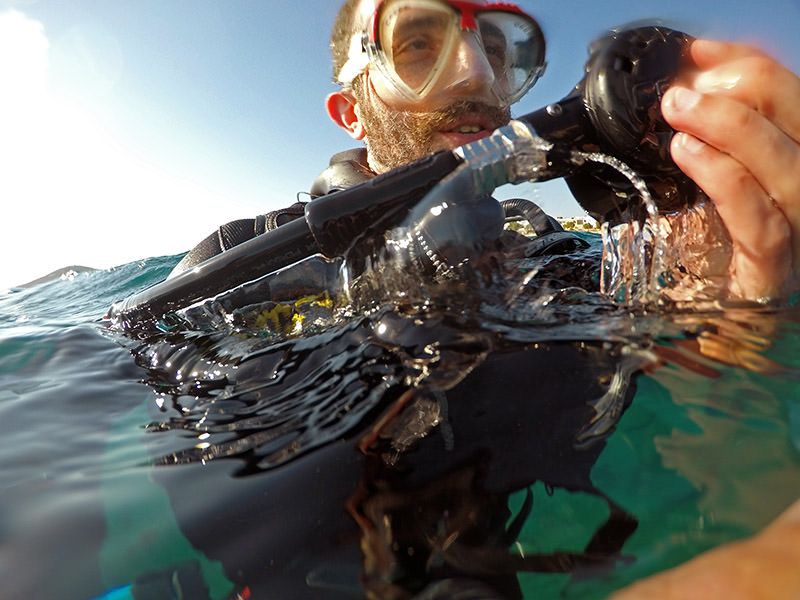
The entire breathless ordeal lasted for about 30 seconds, that’s what my GoPro images suggest (set to time-lapse, with shots taken every second). For someone who cannot breathe, and is surrounded by water, those 30 seconds can feel like an eternity.
After a minute on the surface of getting my heartbeat down, I was okay with diving back in. The experience did teach me a lesson of approaching foreign environments with respect, and the importance of learning how to handle them when things go wrong.
Knocking on wood, I was lucky enough not to experience natural catastrophes on the road. Against that reckless power, we are quite defenseless. If you wish to help those whose lives were shattered into pieces, consider these areas as the best places to travel in 2024.
Navigating dangers of travel – conclusion
There you have it, seven years of wild adventures, close calls, and enough adrenaline to fuel a theme park.
Traveling, as I’ve come to learn, is not always easy, especially if we tend to challenge ourselves with experiences that may be out of our comfort zone. They test our resilience and our ability to keep our cool when the going gets tough.
The safety of travel doesn’t always come with an instruction manual
After seven years of working on the Pipeaway project, I am still attracted by the beauty of challenges, even if they come with risks. It’s a constant learning process that reminds me of the importance of – learning.
As individuals, we’re fragile, easily broken by elements and accidents. But we also learn by doing. I do.
Experiencing travel problems is an ongoing education in travel safety, a process that makes us resilient and better prepared for future challenges. It helps us survive travel emergencies that we can’t always imagine beforehand.
When I look at these experiences that expose how thoughtlessly I approached some of my adventures, I wonder what makes me eligible to give safety tips or any advice for traveling.
But you know, it doesn’t take an expert to understand that the safety of travel and the health risks we challenge abroad don’t always come with an instruction manual.
The dangers of travel should not deter you from adventurous travel. Don’t let the fear of the unknown hold you back from pushing your boundaries. Learn from your mistakes, but also from those of others. Stumbling is a part of the adventure. We get better with experience.
As I raise a metaphorical toast to the next seven years of Pipeaway adventures, I offer my safe travel wishes to all wanderers. May good luck accompany your willingness to adopt new skills, and take you far. Stay safe, and pipe away!
Have you experienced the dangers of travel?
Share your riskiest adventures in the comments, and pin this article for later!
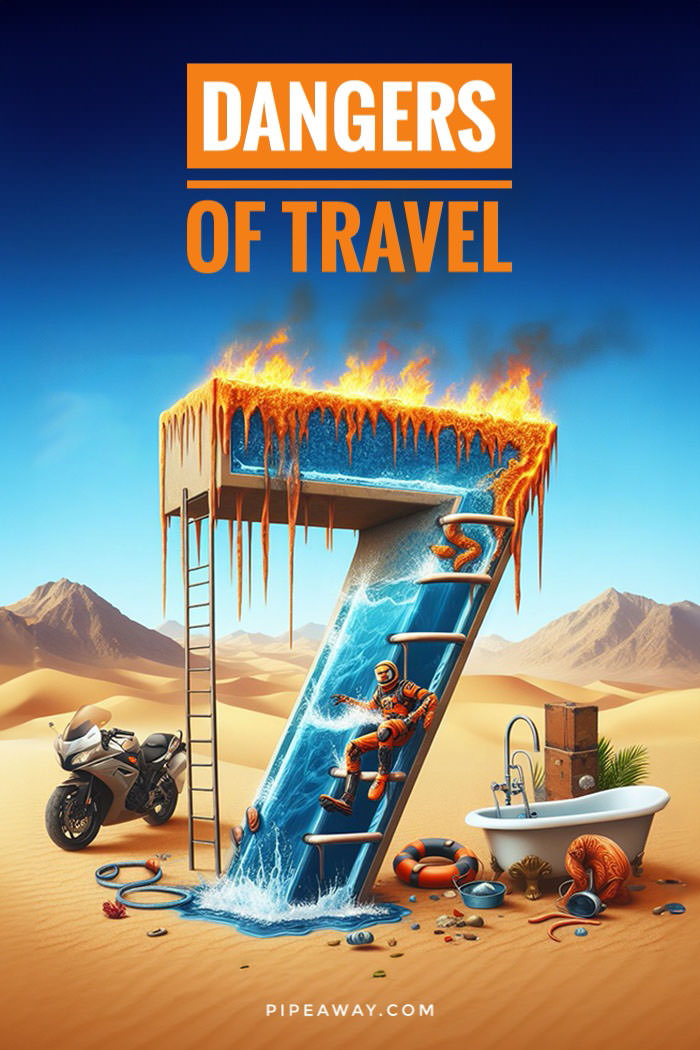
Disclosure: This post may contain affiliate links, meaning if you click on them and make a purchase, Pipeaway may make a small commission, at no additional cost to you. Thank you for supporting our work!

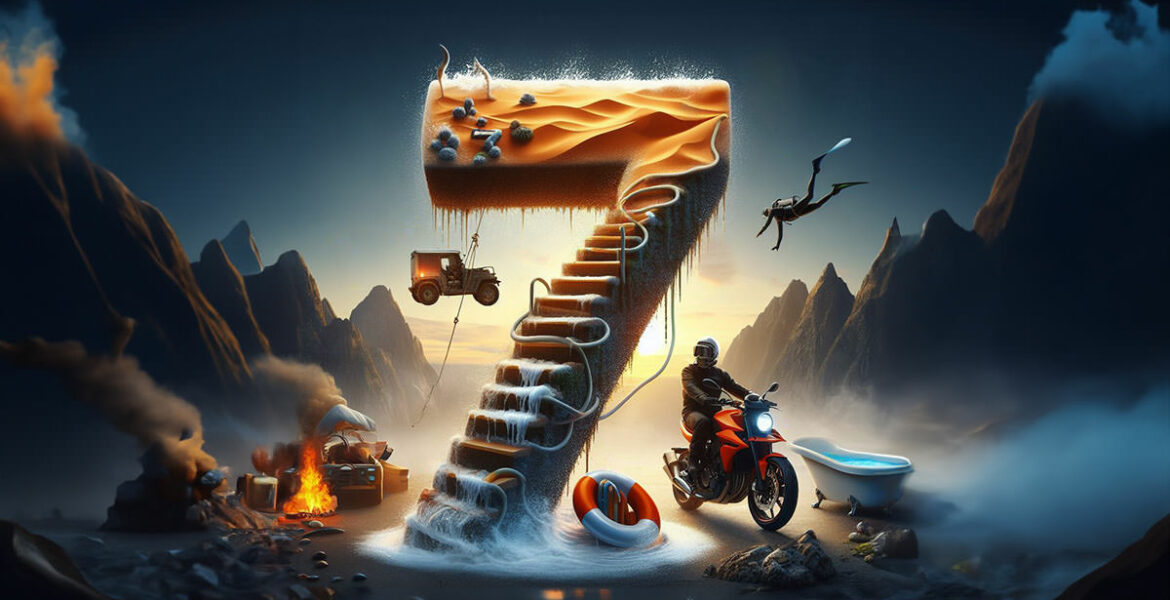

Glad you survived these 7 incidents! I like your statement: “Stumbling is a part of the adventure. We get better with experience.” It’s great to keep in mind as I am still rehabbing an injury to my wrist that I got while traveling a few months ago.
Hi Sonia,
It’s true that sometimes the unexpected twists and turns of travel can lead to mishaps, but they often become part of the adventure and make for some memorable stories.
I’m sorry to hear about your wrist injury, and I hope your recovery is going smoothly. May I ask how did that happen?
Remember, every stumble is a lesson learned, and each experience makes us stronger and more resilient. Keep pushing forward, and before you know it, you’ll be back out there exploring the world with renewed vigor.
Wishing you a speedy recovery and many more safe travels ahead!
Ivan
This article is reassuring. Glad I’m not the only one who has hurt themselves significantly while slipping down stairs or in the bathroom!! That’s probably the most dangerous part of travel haha.😂
Hi Kristin,
It’s true, slipping down stairs or in the bathroom can happen to the best of us, even when we’re out exploring the world. Who knew that such mundane moments could turn into the most perilous parts of our travels, right? 😄
But hey, it’s all part of the adventure! Sometimes, a little stumble adds a bit of excitement to our journeys.
Here’s to more safe travels and hopefully fewer slip-ups in the future!
I’m wondering if you are you accident prone when you aren’t traveling? When I travel I always for a walk in shower. I know that these aren’t always available, but when they are it really helps.
Thanks for your comment, Amy!
As a matter of fact, I don’t consider myself accident-prone at all 🙂 It felt I had to dig deep to find these souvenirs haha. But I guess accidents do happen, I just erase them from my memory too quickly.
Even for travel insurance, I just realized, I used it a lot for lost or damaged bags, but I haven’t tried to get personal compensation for any of these events. I’m sure that Finnish hotel would have accepted to pay at least for the doctor’s invoice, if I had asked, but I haven’t even thought of that. In the States, I’m sure a good lawyer could have made me rich with a lawsuit or two haha.
As for walk-in showers, I mostly use those! I sometimes miss bathtubs, and the opportunity to lie down and just soak. These days, I often see it as a privilege I sometimes indulge in when staying at hotels and resorts. But yeah, that quick shower in Helsinki turned into a long recovery, luckily with no long-term consequences, at least to my knowing.
Safe travels!
Ivan
Wow, and to think that I worry my family when I go on adventurous trips and excursions when traumatic and debilitating things can happen just in a hotel bath if you slip the wrong way!! Glad there were no permanent injuries!!
You’re absolutely right, Michelle!
It’s incredible how a simple slip in the hotel bath can turn into a memorable (albeit not in a good way) travel experience!
While adventurous trips definitely come with their own set of risks, it’s often the unexpected moments that catch us off guard.
Fortunately, I was lucky to escape permanent injuries from these mishaps, but they certainly serve as a reminder to stay cautious, no matter where our travels take us.
Take care of yourself on those excursions AND when taking a shower afterwards!
I can relate to bathrooms as unexpected danger zones on the road. We get so accustomed to our home turf that the whole bathroom choreography – stepping out of the shower, grabbing a towel – becomes second nature. But get into a new layout while traveling and it seems proprioception goes all wonky. Move the wrong way, and suddenly, you’re just trying to stay upright. And don’t even get me started on those extra shiny, hazardously slick floors!
Hey Darla,
I agree, something as routine as stepping out of the shower can become a high-stakes balancing act when you’re in unfamiliar territory.
Truthfully, I did contribute to the event. I could have prepared the towel to be somewhere closer, and not hanging on that bathroom door, which was clearly out of safe reach.
Of course, it would have also been safer to get out of the bathtub first, and then grab the towel. But noooooo, God forbid Ivan leaving wet trail on the bathroom floor! He has to dry himself while still standing in the bathtub! Except that in this case, standing in the bathtub quickly turned into lying down in the bathtub.
Traveling definitely has a way of throwing off our proprioception and turning the simplest tasks into potential hazards.
But we, the travelers, could also choose not to switch our minds off when they’re most needed.
Stay safe, and upright!
I.
Love your spirit of adventure! Enjoyed this article.
Thanks, Liz! I’m glad you enjoyed the article.
Adventure is the spice of life, they say. Here’s to many more ahead!
I both chuckled and undoubtedly had looks of horror on my face all at that same time. My favorite line in the whole post is “because that’s not sexy.” Truth…that may be inspiration for a future article for me. LOL! I love this article because it’s so transparent. We do go through hardships and I may or may not have some stories of my own. I will say the scariest of your dangers (to me) was the long breath holding in Greece. I am not claustrophic but I fear I would be under water and it’s the ONLY reason I have gotten my cert yet. The most painful had to be the fractured ribs. You might need to pack some bubble wrap for the future! 😛
Hey Heather,
I’m so glad to hear that the article resonated with you!
It’s true, sometimes the most harrowing experiences make for the best stories, even if they’re not always glamorous.
And hey, if my misadventures can serve as inspiration for your future article, then I consider that a win-win! 😄
Thanks for your suggestion on packing some bubble wrap for the future – it might not be a bad idea! I’ll have to add that to my travel checklist!
i.